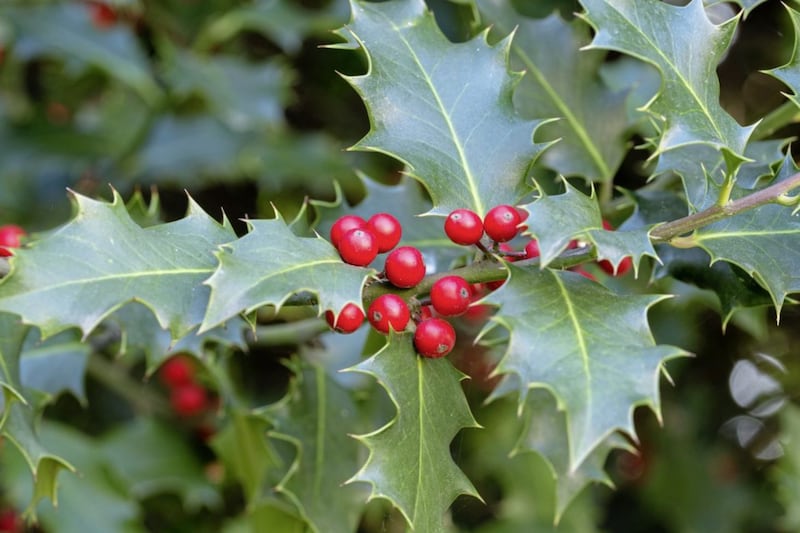OVER the coming days, many of us will probably have some form of holly (llex aquifolium) in our houses, whether a real branch from a tree or a picture on a card. We have been ‘decking our halls’ with boughs of holly for many centuries, even before the advent of Christianity.
A broadleaved, slow-growing tree with glossy green leaves, wavy margins and sharp spines, holly often forms an under-storey species in mixed woodlands, with its red berries a rich source of food for birds such as redwings, fieldfares and mistle thrushes. The impenetrable bush also offers a welcome winter shelter for songbirds.
Holly’s first recorded use appears to have been by the Romans, who used it for decoration at their Saturnalia festival, originally held on December 17 but later expanded through to the 23rd and involving festivities, private gift giving and continual partying. This was a thanksgiving to their god of agriculture and harvest, Saturn.
In our own Celtic traditions, the holly tree, cuileann in Irish, was considered a powerful and magical plant. In the legend of the battle between the Oak King and the Holly King, these two mighty rulers were said to fight for supremacy as the wheel of the year turned each season.
At the summer solstice the Holly King defeats the Oak King to reign all the way through to the winter solstice when sprigs of holly were worn by the druids at festive rituals. This was followed by a period of supremacy by the Oak King through to the summer again.
The druids also believed the holly to be a sacred tree not to be felled. It is one of seven noble trees listed in the seventh century Irish legal document/poem ‘Crith Gablach’, which states;
Thou shalt not cut a sacred tree.
A danger from which there is no escape
Is the penalty for felling the sacred tree
Cuttings from this revered tree were also brought into houses to protect the home from malevolent forces and a self-seeded holly plant growing close to a house kept the inhabitants safe from fire, lightning strikes and nightmares.
The emergence and spread of Christianity resulted in many ancient Celtic customs, including the use of holly being recast and used in the seasonal celebrations surrounding Christmas and the new year. However, the Church was not always keen on evergreen decorations. The use of holly to decorate homes at Christmas was forbidden for a time by sixth century archbishop Martin of Bracara Augusta (now Braga), Portugal, because of its origins as a pagan practice.
He was fighting a losing battle though as gradually holly, often paired with ivy, became an important feature of Christmas symbolism and decoration.
The name christdorn is used in Germany for holly meaning ‘Christ thorn’, a reminder to Christians of Jesus’s suffering and a nod to the legend that his crown of thorns was made from the holly bush. The well known anonymous Christmas carol The Holly and the Ivy, from the 1700s, uses the holly’s white blossom, red berries and bitter bark to demarcate the stages of Jesus’s life, where the holly and ivy are used as metaphors for Jesus and Mary.
The red berries recall the blood and passion, the white flowers Christ’s purity and the very bitter bark, suffering and a possible reference to the drink offered to Jesus as he hung on the cross. One verse reads;
The holly bears a prickle,
As sharp as any thorn,
And Mary bore sweet Jesus Christ
On Christmas Day in the morn.
Nollaig Shona daoibh. Happy Christmas.




